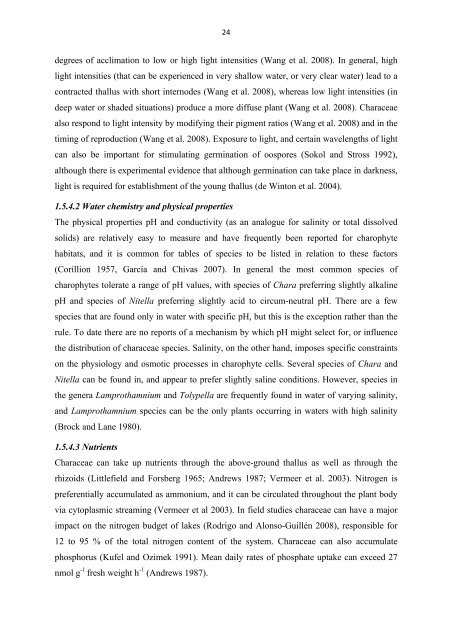Chapter 1: The Characeae Plant
Chapter 1: The Characeae Plant
Chapter 1: The Characeae Plant
Create successful ePaper yourself
Turn your PDF publications into a flip-book with our unique Google optimized e-Paper software.
24 <br />
degrees of acclimation to low or high light intensities (Wang et al. 2008). In general, high<br />
light intensities (that can be experienced in very shallow water, or very clear water) lead to a<br />
contracted thallus with short internodes (Wang et al. 2008), whereas low light intensities (in<br />
deep water or shaded situations) produce a more diffuse plant (Wang et al. 2008). <strong>Characeae</strong><br />
also respond to light intensity by modifying their pigment ratios (Wang et al. 2008) and in the<br />
timing of reproduction (Wang et al. 2008). Exposure to light, and certain wavelengths of light<br />
can also be important for stimulating germination of oospores (Sokol and Stross 1992),<br />
although there is experimental evidence that although germination can take place in darkness,<br />
light is required for establishment of the young thallus (de Winton et al. 2004).<br />
1.5.4.2 Water chemistry and physical properties<br />
<strong>The</strong> physical properties pH and conductivity (as an analogue for salinity or total dissolved<br />
solids) are relatively easy to measure and have frequently been reported for charophyte<br />
habitats, and it is common for tables of species to be listed in relation to these factors<br />
(Corillion 1957, García and Chivas 2007). In general the most common species of<br />
charophytes tolerate a range of pH values, with species of Chara preferring slightly alkaline<br />
pH and species of Nitella preferring slightly acid to circum-neutral pH. <strong>The</strong>re are a few<br />
species that are found only in water with specific pH, but this is the exception rather than the<br />
rule. To date there are no reports of a mechanism by which pH might select for, or influence<br />
the distribution of characeae species. Salinity, on the other hand, imposes specific constraints<br />
on the physiology and osmotic processes in charophyte cells. Several species of Chara and<br />
Nitella can be found in, and appear to prefer slightly saline conditions. However, species in<br />
the genera Lamprothamnium and Tolypella are frequently found in water of varying salinity,<br />
and Lamprothamnium species can be the only plants occurring in waters with high salinity<br />
(Brock and Lane 1980).<br />
1.5.4.3 Nutrients<br />
<strong>Characeae</strong> can take up nutrients through the above-ground thallus as well as through the<br />
rhizoids (Littlefield and Forsberg 1965; Andrews 1987; Vermeer et al. 2003). Nitrogen is<br />
preferentially accumulated as ammonium, and it can be circulated throughout the plant body<br />
via cytoplasmic streaming (Vermeer et al 2003). In field studies characeae can have a major<br />
impact on the nitrogen budget of lakes (Rodrigo and Alonso-Guillén 2008), responsible for<br />
12 to 95 % of the total nitrogen content of the system. <strong>Characeae</strong> can also accumulate<br />
phosphorus (Kufel and Ozimek 1991). Mean daily rates of phosphate uptake can exceed 27<br />
nmol g -1 fresh weight h -1 (Andrews 1987).
















